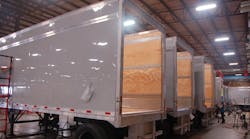An unprecedented set of economic unknowns has made business planning particularly challenging, but the commercial vehicle industry analysts at ACT Research and FTR Transportation Intelligence continue to try to make sense of the uncertainty. The gist: Freight levels and carrier profitability have bottomed out, but the strength and speed of the recovery still is a tough call to make. For equipment OEMs, that means 2020 can’t end soon enough, but a full recovery will be well underway by next year, leading to a robust 2022.
“There's just a tremendous amount of uncertainty right now … and there is an end in sight,” Steve Tam, ACT vice president, said during a June 3 HDMA Pulse Webinar. “But we are also concerned about the possibility of a second wave of infections as economies start to reemerge or restart. My crystal ball these days has the opacity of a bowling ball. It's just very difficult to see beyond the next couple of months, particularly as it relates to the virus and the path that it's sending us down.”
ACT estimates the Q2 GDP is going to be down 37.4%, about the middle of other forecasts that range from declines of 35-40%. Some economic indicators from May have turned slightly upward, he pointed out, providing “little silver linings” for the outlook.
Among his bullet points on the freight effects of the pandemic, Tam noted the “unprecedented” decline in manufacturing, including the virtual shutdown of the auto industry; the disproportionate impact on services such as airlines and restaurants; significant supply-chain disruption, including the loss of backhaul opportunities for trucking companies; and even greater shifts to online retail, providing more final-mile delivery opportunities.
“Interestingly enough, from a carrier perspective—whether we have a long recovery or a short recovery—they’re going to be pretty well positioned to take advantage of either of those scenarios,” Tam said. “Carriers are going to figure this out and then benefit, and that's important because it's really their profitability that drives what happens in our industry.”
For commercial equipment manufacturing to return to “normal” levels, however, the market first is going to have absorb excess capacity.
“We have too many trucks, and there's just not enough freight,” Tam said, adding that nearly 90,000 for-hire trucking jobs were lost in the April federal employment report, and that means a lot of equipment now is parked.
But owner-operators are leaving the market, he noted, and taking some of that excess capacity with them.
Freight numbers
And rates on the spot market picked up in May after “bottoming out” in April, explained Avery Vise, FTR vice president, trucking—and he expects volumes to keep rising. However, according to the FTR COVID-19 truck Freight Recovery Index, which discounts seasonal freight trends, even with the steady climb from May into June, freight volume still hasn’t emerged from the “restart phase” to reach the “full recovery phase,” where the index approaches pre-pandemic levels.
“June is the peak month in the spot market, and we're already starting to see tougher seasonal comparisons,” Vise said in a June 4 FTR State of Freight webinar. “So we will have to watch this closely, and we’ll frankly need an acceleration of the load volume increases that we've been seeing in order for the index to keep moving higher.”
The dry-van segment of the carrier market “continues to be the best-performing,” and reached the full recovery phase by late May, Vise reported—although the dry-van index did slip the first week of June. The refrigerated segment recovered quickly from the shutdown phase, and held steady at the high end of the restart phase through May before also taking a downturn in early June. Flatbed freight has been the slowest to recover.
“This will be interesting to watch,” Vise said. “Flatbed was doing quite well heading into the COVID crisis because of the strength of the residential construction market. And now, as we start to come out of the crisis, we have mortgage rates that are near record lows.”
“Choppy” is the word Don Ake, FTR vice president of commercial vehicles, used to describe the equipment market.
“We're looking at choppy data; we're looking at choppy trends; we're looking at a choppy market; and that all adds into a choppy recovery,” Ake said. “We're moving upward, but not smoothly.”
Ake noted that the Witte Econometrics/FTR forecast for GDP had been revised to suggest that the second quarter (down 22%) will not turn out to be as bad as previously expected—but the third quarter (a gain of 13.9%) will not be as strong.
Similarly, the freight loadings forecast has been revised to show the worst was not as low as initially thought but the recovery will not be as strong.
“It is still very weak, until we get into next year,” Ake said
Equipment trends
FTR reported preliminary Class 8 net orders of 6,614 units, up from 4,105 order in April—still low, but Ake anticipates an upward trend.
“Even though the market is down because of the extraordinary events that we've had to go through, it looks like we could be starting a cycle,” he said. “However, when we get into June, we would expect that number to be higher, but maybe not that much. And again, I would describe it as a choppy improvement.”
Class 8 production likewise crashed in April, a record low that FTR measured at only 2,404 units.
“It's never been this low, but that's because basically the OEMs were shut down for most of the month—some all of the month,” Ake said. “Obviously the shutdowns were due to both the pandemic and worker safety, but it's related to low orders: The OEMs were able to shut down for an extended time because of the industry-high inventory.”
Indeed, April retail sales were a “bright spot,” coming in much higher than expected as fleets bought trucks from that existing inventory.
Even though truck OEMS were able to resume some production in May, Ake noted, they were hampered by supply chain challenges, particularly those with manufacturing facilities in Mexico.
The trailer order number was “as ugly as Class 8 production,” Ake added, coming in at 329 units.
“A lot of cancellations pulled a lot out of the backlog,” he said. “We do, once again, expect the number to increase in May. And I think we’re looking at that same kind of balanced curve up that we saw in the Class 8 orders.”
FTR anticipates May trailer orders to come in at about 6,000 units.
As for trailer production, FTR reported 12,549 units in April, down from just over 19,000 in March but a much stronger performance than the Class 8 production—largely because trailer manufacturers limited their shutdowns. And because some shutdowns spilled over into May, driven by demand as much as COVID-19 concerns, the May production total could be lower than April’s but not by much, Ake explained.
For the longer-term outlook, Ake noted the choppy nature of the recovery means “fleet confidence is shaky.”
“From what I've heard, there still are quotes out there. They may have canceled orders in the backlog, but they didn't pull back a lot of their quotes,” Ake said. “But until the conditions stabilize, they're not going to commit to those orders. That's why orders in the next month or so are probably not going to be that strong until the fleets have the confidence to order for the second half of the year.”
FTR forecasts Class 8 production to reach 152,000 this year, climbing to 195,000 in 2021 and to 290,000 in 2022. Trailer production will reach 163,000 this year (an upward revision from 156,000); 190,000 in 2021 and 270,000 in 2022.
The ACT forecasts are somewhat lower, although Tam pointed to the same general trends.
Noting that Class 8 orders in April were the lowest since 1995 when net orders went negative for a couple of months, Tam explained that the industry is in “a much better position today” but that coming off the recent “outrageous peaks” and a much higher expectation for “normal” levels, the orders “pale in comparison.”
He also offered explanations for several of the recent “anomalous” numbers that do not “make sense.” For instance, while Class 8 net orders and builds crashed in April, retail sales “held up reasonably well.”
But he also added qualifications: The backlog “evaporated” in April because fleets have pushed the delivery schedules on existing orders beyond the 12-month rolling window for which ACT calculates backlog. Retail sales held up because those new trucks already had been built. April production, however, came in at only about 2,500 units, the lowest total since ACT began tracking builds in the 1980s.
“Our concern is that we didn't build a whole lot in in April so we won't have a whole lot to deliver in May,” Tam said. “So it's very likely that we're going to see a pretty meaningful step down in retail sales.”
Indeed, the industry has been “beset by excess inventory” for nearly two years, he added, and that comes to some 25,000 “very speculative” new trucks “sitting on dealer lots,” an excess that will have to come down before production grows again.
The trailer market is going through a “very similar experience” to Class 8, Tam explained, “just skirting” negative orders in April, at about 500 units—“not a very comfortable situation.”
“Because we've seen that decline in orders in a relatively short period of time, we've been working off backlogs,” Tam said. “You're seeing production rates come down—a very, very similar story to the rest of the industry.”
The ACT outlook calls for “a gosh-awful, scary number” in Q2, but a “return to growth in a fairly short period of time,” Tam said.
For Class 8, ACT forecasts only 117,000 units in 2020, down from a record 345,000 in 2019. Truck builds pick up substantially in 2021 to 189,000 and then return to normal level in 2022 with 286,000 units.
The US trailer build will fall to 117,000 units this year, down from the record 333,000 in 2019. ACT forecasts 199,000 trailers will be built in 2021, and 253,000 in 2022.
Reviving production
Tam concluded his presentation by outlining five steps that will be necessary for the commercial vehicle industry to get back to full production:
- Testing and contact tracing for the workforce,
- Hygiene protocols,
- Virtual sales, distribution and service activities to the maximum extent possible,
- US Treasury lending to companies that have lost credit lines, and
- Customer means and motivation (tax breaks, deductible interest, cash-for-clunkers and other government incentives).
“The second item, although it's the shortest one on the list, probably has the longest explanation,” Tam said. “It entails everything from ‘How do you configure your assembly line or your manufacturing operation to keep your workers safe?’ to ‘What do you do if a worker becomes infected?’
“How do you handle shift time—do you stagger your shifts or have people come in, in waves? What do you do in the breakroom, in the lunchroom, in the bathroom and all the common areas? Folks are spending just incredible amounts of money on cleaning and sanitizing. It’s turning out to be a new part of our way of life for quite some time.”




